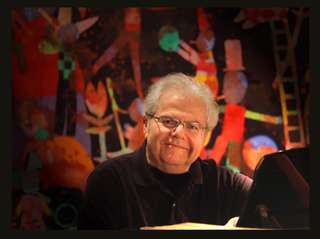|
Back
The Spice of Life New York
Carnegie Hall
05/17/2012 -
Aaron Copland: Piano Variations
Joseph Haydn: Variations in F Minor, Hob. XVII:6
Ludwig van Beethoven: Variations and Fugue on an Original Theme, "Eroica", Op. 35
Robert Schumann: Etudes en forme de variations, Op. 13
Emanuel Ax (piano) 
E. Ax (© Maurice Jerry Beznos)
Emanuel Ax threw down the gauntlet in his risky but imaginative recital of works in variation form with a thrillingly taut reading of Copland's muscular Piano Variations. Ax entered the stage in the most unassuming manner, but the initial four-note motive, punctuated by the dense cluster that activates eery resonance, set the stage not only for the opening work, but for a solid program marked by musical acuity.
After the opening of the Copland, Ax's tone in the tenor range of the piano entranced. The recurring fanfare-like motive was played crisply, as were the quick variations, tossed off with ease and evenness. Ax is clearly in his prime, the breakneck speed of his left-hand octaves handled with prodigious accuracy and the sixteenth-note flurries perfectly placed.
This high level of playing continued throughout the recital. A lesser pianist might turn this program into over-sectionalized compartments of music, each variation within each piece forming its own independent microcosm. Fortunately, Ax projected a thoughtful architecture in each work. Even when some interpretive touches caught one by surprise, the logic behind the choices quickly revealed itself. The nineteenth variation of the Copland, taken slower than is typical, allowed Ax to build a tremendous accelerando leading to a crushing conclusion. The lack of rubato at the beginning of the twelfth Schumann etude made its incorporation later stand out as even more monumental.
Indeed, the concept of the program was nothing short of ingenious. Haydn's undervalued F Minor set foreshadowed Beethoven's Eroica variations, which, in the moments before the culminating fugue, pre-echo the martellato solo opening notes of the Copland set. Ax played up the contrast between the lyricism and angular rhythmic profile of the Copland. He then focused separately on those two aspects, shining the spotlight on the inspired melodies in the Haydn and then playing a rhythmically propulsive, perfectly voiced Beethoven set.
After intermission, the Schumann variations saw a return to the synthesis of Ax's playing styles. Even the interspersing of posthumous etudes here was inspired. Without any of that set, the piece is a non-stop barrage of quick variations from the third until the penultimate eleventh. Ax thoughtfully inserted select posthumous etudes to make the entire piece feel tripartite, breaking up the tension of the quick variations and letting us bask every now and again in shear lyricism. Highlights included his ethereal sotto voce in the fifth posthumous etude, the transformative, expertly limned aria of the eleventh etude, and the brisk but accurate culminating variation, which deservedly brought the audience to its feet.
Ax rewarded the acclaim with two variations on the waltz: Liszt's first Valse oubliée and Chopin's Valse brilliante (Op. 34/1), both entrancing in their musicality and lilting rubato.
Marcus Karl Maroney
|